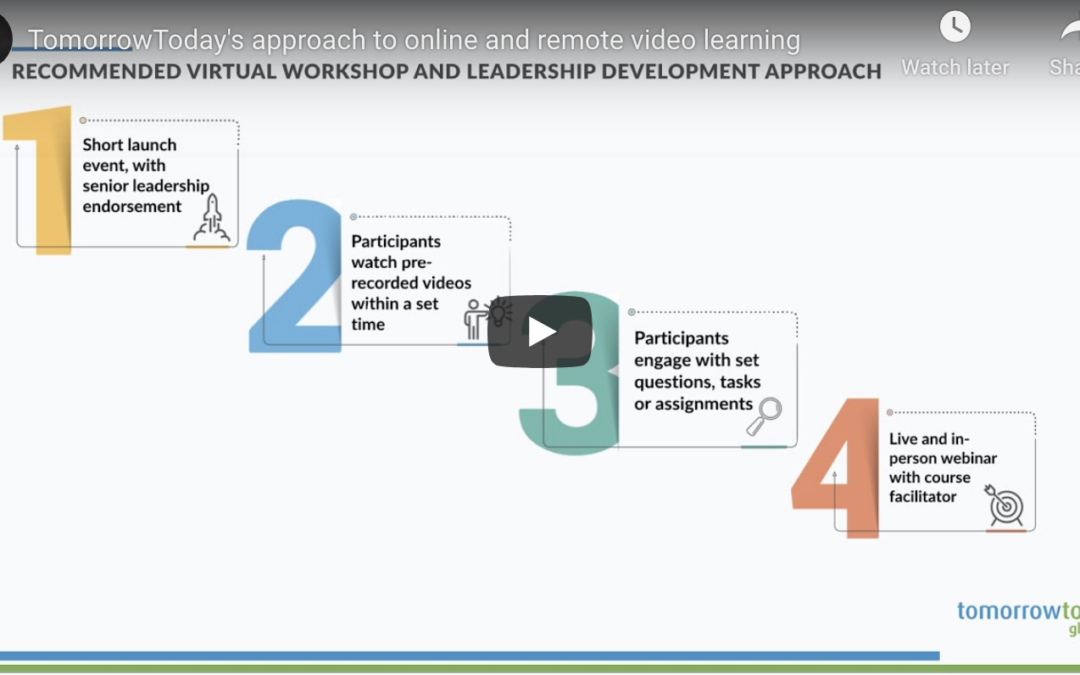The worst thing that you can do right now, if you are shifting your training, your workshops, your leadership development online, is to take what you would have done in the classroom and just dump it online. And so many people are doing that.
We’re getting requests from clients all the time asking, “Can you do a one day workshop in a webinar format?” No, is the answer. That just doesn’t work. You have to think differently when you’re online. It’s not just about shifting your content into a virtual space or into a digital space. At TomorrowToday, we use a four-step process. And when we do work with you, this is what we’d recommend. And hey, maybe you should just do this with your courses.
Step two (I’ll get to step 1 below!) is the delivery of the content. So there’s information to transfer. There’s engaging content you want to get across to people, and our recommendation is that you pre-record this. The reason for that is you’re then not trying to do something live. Maybe you’re doing it from your home even and you don’t have a whole crew around you. So you probably not going to show good graphics or multimedia, you’re not going to be as interactive as you might want to be. And you’re also doing it live, which means you can’t edit it and get it to sharpen as crisp as you want to. So we highly recommend that the data transfer the information transfer section of a course is pre-recorded, and then shown to participants.
Now back to step one, you don’t just want to put a video up on YouTube and send a link to participants and say watch this video. Most people are probably not going to do that. So step one is to have a short launch event. Kind of open the training on a day – preferably get in a senior executive. We know what that does in training, everybody turns up when the senior execs are around and get a senior executive kind of welcome. Explain the value and the purpose of the training – which can just be a 10 or 15-minute webinar that is done live. And then you announce that the video is now available. Put the video on a YouTube private platform or maybe your own learning and development platform. And then you launch the video so it becomes available, and people have a few days in which they need to watch it.
Now, step three is important. It links onto that you need to get people to do something in response to watching the video. Part of that, to be honest, is just to make sure that they’ve watched the video. So you will tell them that during the course of the video towards the end of the video, they will be given instructions on the task or assignment. They’ve got, let’s say three or four days to watch the video. Then they have a few days to do the assignment. The assignment includes giving feedback to the course facilitator. It might be in the form of questions you want to ask or some assignment that responds to the content. This obviously is dependent on what it is that you’re trying to teach them. But Step three is that the participants have to do something, either on their own or in groups.
And step four, then is a live session, a live session that’s done with the course facilitator, and the participants. This might be done in small groups, if it’s a large group of people, or you might get everybody together. And the live session at the end, again, depends on the content could be anything from as simple as literally a Q&A session with the course facilitator to an interactive session that is designed for a large group of people to engage with each other and make sure that you cement the content and cement the value that you’re supposed to be learning from the program. All of that will actually take less time than the course would have taken if people had done it in a classroom. So we’re not asking people for more time, we’re just delivering it in four steps that allow people to engage with it better in a virtual or a remote or an online learning environment.
These four steps are what we do all the time at TomorrowToday and, over the last few weeks and months of this COVID crisis, we’ve been seeing real success with our clients. We can take any of our workshops and any of our content and deliver it in this way to your team and we’d love to do that with you. But even if you don’t use us, I hope that these four steps have been useful to you in how you might adjust your content for an online remote environment.


